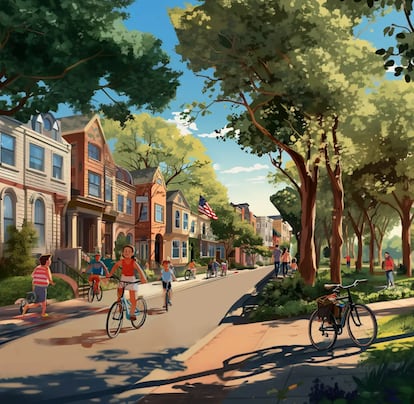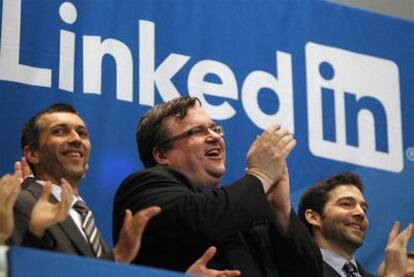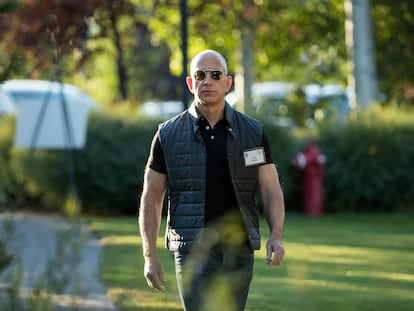The new California city envisioned by Silicon Valley tech moguls
A group of tech heavyweights has purchased 20,000 hectares of agricultural land with the goal of creating a safe, environmentally responsible community with affordable housing
For Silicon Valley tech moguls, the perfect city has narrow streets where people are prioritized over vehicles. It is home to many trees and green areas. There is a lot of life outdoors. Restaurants have outdoor eating areas and there are lots of pedestrian streets filled with shops. Children ride their bikes freely, and their parents don’t have to be concerned about their safety. This city is close to nature, where residents can visit a small lake and paddle out on a kayak to enjoy the Northern California sunset. This is the secret city that a group of billionaires has been developing for years.
But last Thursday, the only living thing on this land were cows. The dream city — still unnamed — is set to be built in an area dominated by wind farm turbines and high-voltage towers. There are no buildings or homes and only a few dirt roads branch off from Highway 12, which connects the towns of Fairfield (120,000 inhabitants) and Río Vista (10,200 inhabitants), located halfway between Sacramento, the capital of California, and San Francisco. The route is flanked by ranches and immense fields that have turned orange from the summer heat. Much of the traffic that passes through flows toward the Napa Valley and its vineyards.
A powerful group of tech entrepreneurs has chosen this place in Solano County to build their city from scratch. The plan consists of building three or four medium-sized towns with affordable, walkable and environmentally friendly housing. “Residents want more opportunities to buy homes in safe, walkable communities. Good paying local jobs, so they can both live and work in the county,” reads the website for the California Forever project, which was launched last week.

The project used a company called Flannery Associates to buy 50,000 acres of agricultural land located about 500 miles northeast of San Francisco, near Travis Air Force Base. The land, which cost $800 million in total, was bought up over a period of four years and in secret. The group admits this understandably triggered “interest, concern and speculation.” Some thought that Disney had bought the land for an amusement park in the north of the state.
Some of the most prominent names in the U.S. technology and financial sector are behind Flannery Associates. The list includes Marc Andreessen, who leads Andreessen Horowitz, a $35 billion investment fund; brothers Patrick and John Collison, the founders of Stripe, who have a fortune of more than $1 billion; entrepreneur Chris Dixon; venture capitalist John Doerr, who invested very early in Compaq, Netscape, Symantec and Sun. Flannery Associates also includes Steve Jobs’ widow, businesswoman and philanthropist Laurene Powell; Reid Hoffman, one of the co-founders of LinkedIn; Nat Friedman, the founding programmer of GitHub and housing justice activist; and Michael Moritz, a partner at Sequoia Capital, which made early investments in PayPal, Yahoo, Kayak and Google, and which has $85 million in capital.
The impressive names behind Flannery Associates meant that the group was able to buy 140 parcels of land, some at a very low price. In an email to another investor, Moritz said that they had bought 1,400 acres for less than $5,000 per acre. The market price for a similar acreage in California would be more than $13,000, according to the Department of Agriculture. The buying frenzy, which offered to purchase land from owners who were not selling their property, ended up inflating prices. Flannery Associates has even taken landowners to court after considering that some sellers exorbitantly inflated the value of their land.

The group has bought 55,000 acres of land, which is double the size of San Francisco, a city that has been declining for years due to safety problems, the Covid-19 pandemic and a growing homeless population from the lack of decent housing. According to the California Forever website, eastern Solano has “low fire risk, access to water, and [is] strategically located in the middle of the larger Northern California region.”
But California Forever’s dream of a utopian city has not convinced all residents in Solano County. Michael Gray, a member of a local hunting club, says the land where he shoots ducks is safe because it is legally protected. “I wouldn’t like to look out the window of my house and see buildings where I now see countryside. I think it could affect the club’s business if they fill areas near the farm with buildings,” says Gray, who is dressed in camouflage and armed with a rifle. The hunter, originally from Fairfield, a city of 120,000 people, is skeptical of the ambitious plans. “I don’t understand where they intend to get the water from. There is no water in this area for so many people,” he says.

Flannery Associates says it has interviewed 2,000 Solano County residents. Eight out of 10 parents think that their children will have to leave the area when they grow up, because there are not enough opportunities. For that reason, many are optimistic about the tech investors’ dream city. This is true of Julián Ríos, from Mexico, who has lived in Fairfield since 1989 and works in construction, installing roofs. “It’s very positive... As long as it means jobs for us, it seems good to me,” says Ríos, who is on temporary leave due to a leg injury.
California Forever officials say the next step is to open a conversation with all residents in the county. In the next few days, they will send a questionnaire to all homes in Solano County to find out their concerns. After that, they will meet with county authorities. The idea has sparked interest across the United States. But Representative Mike Thompson warned that it is a very long-term project. “It is clear that they don’t have a plan; they have a vision,” he said in a press release after meeting with Jan Sramek and Andrew Acosta from Flannery Associates.
Some housing experts estimate that it will take at least a decade for the project to start to crystallize. And more time will pass before the urbanization is called a city. For it to officially be a city, it would need more than 1,000 people, as outlined by the rules of the U.S. Census Bureau. In recent years, a handful of cities have been created after splitting off from another city due to population growth. Westlake in Florida is a similar project to what is being planned in California. The city, incorporated in 2016, was created by the Canadian real estate developer Minto Communities. After seven years, it now has a population of 1,500 people.
Greg Oaklander lives in one of these cities that developed practically from nothing. This building inspector lives in Vacaville, 10 miles from the land acquired for the California Forever project. The area was farmland at the end of the 19th century, and today is home to more than 100,000 people. That is why he welcomes the new proposal from the tech giants. “Despite the wind and heat in summer, it is a good place to live. The landscape is beautiful, it is a quiet area, there is a lot of nature and the terrain is easy to shape, there are no big mountains,” he says. Time will tell if California gets its 483rd city.
Sign up for our weekly newsletter to get more English-language news coverage from EL PAÍS USA Edition
Tu suscripción se está usando en otro dispositivo
¿Quieres añadir otro usuario a tu suscripción?
Si continúas leyendo en este dispositivo, no se podrá leer en el otro.
FlechaTu suscripción se está usando en otro dispositivo y solo puedes acceder a EL PAÍS desde un dispositivo a la vez.
Si quieres compartir tu cuenta, cambia tu suscripción a la modalidad Premium, así podrás añadir otro usuario. Cada uno accederá con su propia cuenta de email, lo que os permitirá personalizar vuestra experiencia en EL PAÍS.
¿Tienes una suscripción de empresa? Accede aquí para contratar más cuentas.
En el caso de no saber quién está usando tu cuenta, te recomendamos cambiar tu contraseña aquí.
Si decides continuar compartiendo tu cuenta, este mensaje se mostrará en tu dispositivo y en el de la otra persona que está usando tu cuenta de forma indefinida, afectando a tu experiencia de lectura. Puedes consultar aquí los términos y condiciones de la suscripción digital.
More information
Archived In
Últimas noticias
Most viewed
- Sinaloa Cartel war is taking its toll on Los Chapitos
- Oona Chaplin: ‘I told James Cameron that I was living in a treehouse and starting a permaculture project with a friend’
- Reinhard Genzel, Nobel laureate in physics: ‘One-minute videos will never give you the truth’
- Why the price of coffee has skyrocketed: from Brazilian plantations to specialty coffee houses
- Silver prices are going crazy: This is what’s fueling the rally











































